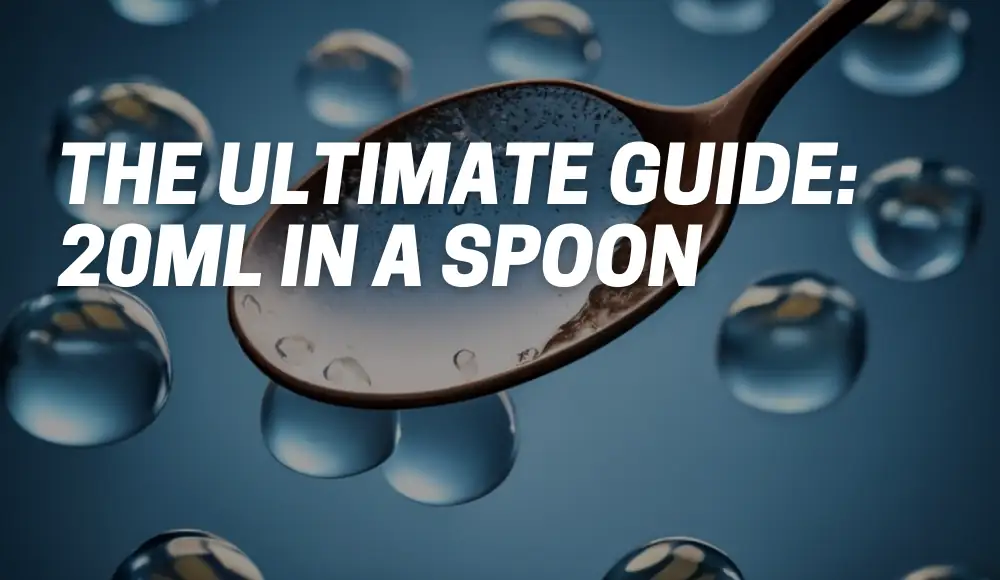When it comes to cooking and baking, precise measurements are essential to ensure your dishes turn out just right. One common query that often pops up in the culinary world is, “How much is 20ml in a spoon?” We’ll answer this and many more questions in this comprehensive guide. We’ll cover everything from the standard measurements of kitchen spoons to practical tips for achieving accuracy in your culinary adventures.
Is a Tablespoon 15 or 20 ml?
The standard tablespoon holds 15 milliliters (ml) of liquid. This measurement is a widely accepted standard in cooking and baking across various countries. However, it’s crucial to note that there are variations in the size and capacity of tablespoons, which may slightly differ from region to region in different countries.
How Many ml is a Regular Spoon?
The term “regular spoon” is somewhat ambiguous when it comes to precise measurements. Generally, a regular spoon might refer to a teaspoon, which holds approximately 5ml of liquid. This is also known as a “teaspoon.”
How Many Spoons is 20 ml?
If you’re working with a standard teaspoon, which holds 5ml, you’d need four teaspoons to make up 20ml. Alternatively, if you’re using a tablespoon that holds 15ml, you’d require approximately 1.33 tablespoons to measure 20ml accurately.
Is 20 ml the Same as 2 Teaspoons?
No, 20 milliliters (ml) is not the same as 2 teaspoons. Here’s the conversion:
- 1 teaspoon is approximately equal to 5 milliliters.
So, 2 teaspoons would be approximately 10 milliliters (2 x 5 ml = 10 ml), not 20 ml.
How Much is 20 ml of Cough Syrup?
Cough syrups vary in concentration and may not necessarily follow a strict 20ml dosage. To find out the exact dosage for your specific cough syrup, it’s essential to consult the label and, if in doubt, seek guidance from a healthcare professional. It’s crucial to measure medications accurately for safety and effectiveness.
How to Measure 20ml with a Spoon
To measure 20 milliliters (ml) with a spoon, you can use a standard kitchen measuring spoon. A common method is to use a tablespoon, as it is equivalent to 15 ml, and then add an additional 5 ml using a teaspoon. Here’s how to do it:
- Use a tablespoon: Fill a standard kitchen tablespoon to the top, which will give you approximately 15 ml.
- Use a teaspoon: Fill a standard kitchen teaspoon to the top, which will give you approximately 5 ml.
By using both a tablespoon (15 ml) and a teaspoon (5 ml), you can measure a total of 20 ml.
Please note that this method is not as precise as using a measuring cup or a syringe specifically calibrated for milliliters, but it can provide a reasonable approximation for most cooking and baking needs.
How to Convert Milliliters to Spoon Measurements
Converting milliliters to spoon measurements is a handy skill for any home cook. Here are some common conversions:
- 1ml = 1/5 teaspoon
- 5ml = 1 teaspoon
- 15ml = 1 tablespoon
- 20ml = 4 teaspoons or 1.33 tablespoons
Remember, these conversions are based on standardized measurements and might not apply to irregularly sized spoons.
Best Kitchen Tools for Accurate Measurements
While spoons are versatile and essential kitchen tools, you might want to invest in some more accurate measurement tools for precise cooking and baking. Consider purchasing measuring cups, measuring spoons, and a kitchen scale for more reliable results in your culinary endeavors. Here are some of the best kitchen tools for accurate measurements:
- Measuring Cups and Spoons: These are essential for both dry and liquid ingredients. Look for sets that are made of stainless steel or durable plastic and have clear, easy-to-read markings.
- Kitchen Scale: A digital kitchen scale provides highly accurate measurements, especially for ingredients like flour, sugar, and nuts. It allows you to measure by weight, which is often more precise than volume measurements.
- Liquid Measuring Cup: These cups are designed for liquids and have clear markings on the side. Look for one with metric and imperial measurements.
- Measuring Jug: A glass or plastic measuring jug is great for measuring larger quantities of liquids. They often have a spout for easy pouring.
- Measuring Spoons with Long Handles: Measuring spoons with long handles can reach into deep containers and provide more accurate measurements.
- Adjustable Measuring Spoons: These allow you to adjust the volume of the spoon for a precise measurement.
- Digital Thermometer: For accurate temperature measurements, especially when cooking meats or baking bread, a digital thermometer is essential.
- Kitchen Timer: A reliable timer helps you keep track of cooking and baking times accurately, ensuring that your dishes don’t overcook.
- Graduated Mixing Bowls: Mixing bowls with measurement markings are handy for combining ingredients and measuring at the same time.
- Syringe or Pipette: For very precise liquid measurements, especially in scientific or molecular gastronomy, a syringe or pipette can be helpful.
- Calibrated Glassware: In more advanced cooking, calibrated glassware, such as beakers and graduated cylinders, can be used for precise liquid measurements.
- Dough Scraper: This tool helps you measure and cut dough accurately when making bread or pastries.
- Coffee Scale: If you’re into coffee brewing, a coffee scale is essential for measuring coffee grounds and water with great precision.
With these tools, you can achieve consistent and accurate results in your cooking and baking.
Cooking Hacks for Precise Measurements with Spoons
Achieving precise measurements with spoons can be tricky, but there are a few hacks you can use to improve your accuracy:
- Flour and Dry Ingredients: When measuring dry ingredients like flour or cocoa powder, don’t scoop directly from the container with the measuring spoon. Instead, use a spoon to lightly fill the measuring spoon, then level it off with a straight edge, such as a knife or the back of a butter knife. This prevents packing and ensures a consistent measurement.
- Brown Sugar: To measure brown sugar, press it firmly into the measuring spoon to pack it. Level it off with a straight edge for a precise measurement.
- Liquid Ingredients: For liquid ingredients like oil, honey, or molasses, use a glass or plastic measuring spoon with a spout. Fill the spoon to the desired measurement line, and then pour the liquid into your mixing bowl for an accurate measurement.
- Adjustable Measuring Spoons: If you have adjustable measuring spoons, you can easily set them to the desired measurement, ensuring precision for both dry and liquid ingredients.
- Use the Right Size Spoon: When possible, choose the right size measuring spoon for the job. Don’t try to measure a teaspoon of an ingredient with a tablespoon; it’s easier to be precise when using the correct size spoon.
- Multiple Spoons: For larger quantities, especially when measuring multiple tablespoons or teaspoons of an ingredient, use the same spoon repeatedly rather than using a single spoon for each measurement. This reduces inconsistencies due to slight variations in spoon size.
- Leveling Technique: When leveling off ingredients with a knife or the back of a butter knife, make sure to scrape off the excess evenly to maintain precision.
- Warm the Spoon: For sticky ingredients like honey or peanut butter, warm the measuring spoon under hot water or spray it with non-stick cooking spray to help the ingredient slide out more easily and accurately.
- Practice and Consistency: Develop a consistent technique for measuring with spoons. Use the same pressure when filling, leveling, and pouring to maintain accuracy.
- Clean and Dry Spoons: Ensure that your measuring spoons are clean and dry before using them to avoid altering the measurement with residue or moisture.
- Measuring in Stages: For recipes that require multiple measurements of the same ingredient (e.g., adding several tablespoons of flour), measure all the quantities separately rather than trying to double or triple the amount in one spoon.
- Double-Check: When precision is critical, double-check your measurements by comparing them to the markings on the measuring spoons to ensure they are accurate.
By following these hacks and practicing good measuring techniques, you can achieve more precise measurements with your measuring spoons, which will contribute to the success of your recipes.
Common Kitchen Measurement Conversions
Here’s a handy reference table for common kitchen measurements and their milliliter equivalents:
| Measurement | Milliliters (ml) |
|---|---|
| 1 teaspoon (tsp) | 5ml |
| 1 tablespoon (tbsp) | 15ml |
| 1 fluid ounce (oz) | 30ml |
| 1 cup (c) | 240ml |
These conversions should help you navigate your recipes with ease.
Conclusion
In the world of cooking and baking, precise measurements are paramount for achieving culinary success. Understanding how much liquid fits into a spoon is a fundamental skill for any home cook. Whether you’re dealing with teaspoons or tablespoons, knowing the equivalent milliliter measurements is a game-changer. With a bit of practice and the right tools, you’ll become a master of measuring liquids with your trusty kitchen spoons. Happy cooking!
Remember, when in doubt, always refer to reputable sources and use standardized measuring tools for the most accurate results. Cooking is a science, and precision counts!

